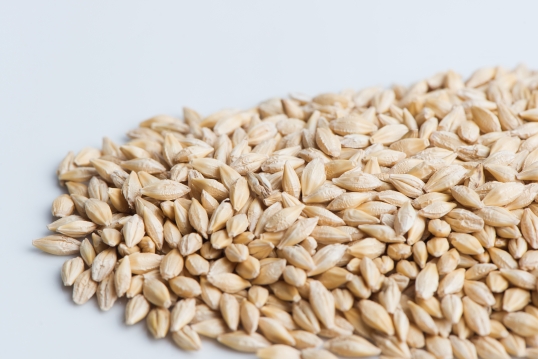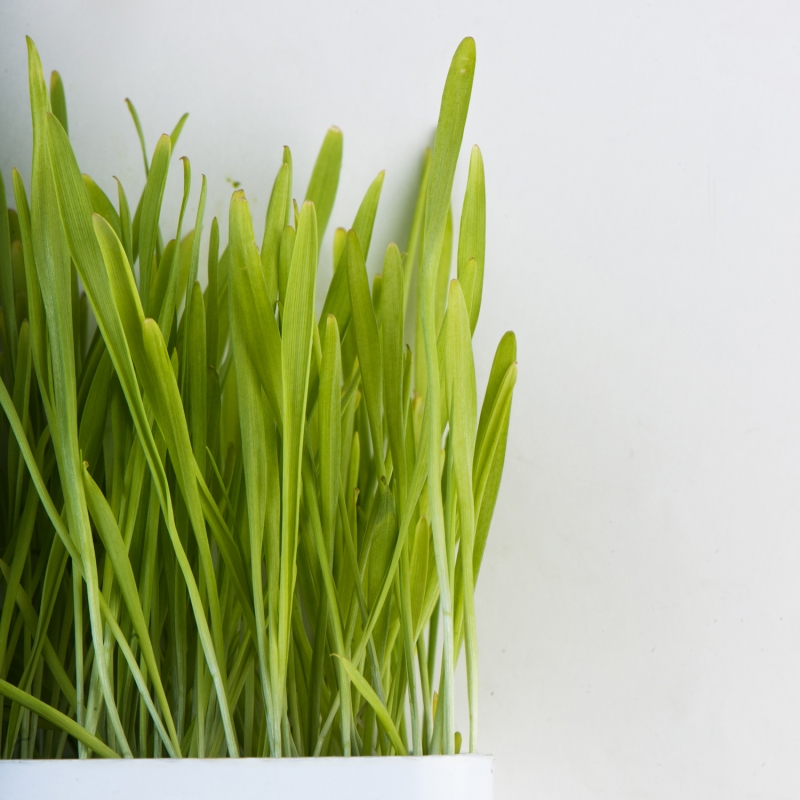Grow highly nutritious barley grass.
- Days to Sprout: Ready to cut and juice in 8 to 10 days
- Soak Time: 6-12 hrs
- Yield: 1 lb. is approx. 2.5 cups of barley seed 1.5 cups barley (approx.) for one 11 x 21 tray of grass 0.5 cups barley (approx.) for large SproutMaster (10 x 8) of grass 10″ x 8″ Sproutmaster yields approx. 2-6 oz. of juice (depends on height of grass, juicer used, density of grass)
- Storage: Our seeds should sprout well for a year after you purchase them, if stored in a cool dry place. If you’d like to extend the germination life of your seeds, store them in the fridge. If you store your seeds in the freezer, they’ll last even longer!
Grow Barley Grass!
- 10” x 20” gardening trays (1-inch-tall preferred), 1 with holes + 1 without. Smaller microgreen trays also work well.
- Good quality organic starting soil mix
- Parchment paper, coroplast, or unbleached paper towel,
- Dome lids (clear or black) or plastic sheet
- Organic seed
- Mister bottle, cup measures, garden spray nozzle (optional)
- Scissors or sharp knife
- Soak seed
Soak seed for 6-12 hours
- Prepare Soil
Add water to top of the bag (or each tray) 12 hours ahead of use until almost fully hydrated. Rehydrate the bag as necessary. If you were to put the soil in your hand and squeeze it, you should not be able to get much more than a drop of water out of it for the perfect moisture content. If you want to mist the seed after putting it on the soil, back off the water hydration of the bagged soil a bit.
TIP: To check for overwatering, tip the tray to one end. Water should not pool enough to drip out of the tray.
- Fill Trays with Soil
Use a tray with holes. Fill with 3/4-1.5” of soil. The closer to the top of the tray the better aid to air circulation. Use a block or your hand to smooth and flatten the soil without compacting it. The back of a tablespoon or spatula smooths out the valleys. You can wait to put the tray without holes under until after unstacking/uncovering or add it to the bottom now.
TIP: Place a layer or two of paper towel on the bottom of the tray before adding soil for easier cleanup.
- Sow the Seed
Sprinkle the seed evenly over the soil in the tray (pizza cheese shaker, spoon). The seeding density depends on the stage at which you’re planning to harvest. For small seeds for 1-week microgreens, start with approximately 15 -28 grams (1.5 – 2 Tbsp). Sow slightly less seed for 2-3 week microgreens.
Seeds do not need misting if the soil has enough moisture. Mist if you need more moisture. Use a spray bottle or a garden spray nozzle set to light mist. The soil should be moist throughout, but not soaking wet.
- Cover the Seed
Doing away with soil as a seed cover decreases the work and time it takes to grow the greens. If stacking the trays on top of each other, use a cover directly on the seed like parchment paper, a plastic sheet or wet unbleached paper towel layer. When not stacking trays, the seed will need protection from drying out by using a dome/lid. Use a clear dome or an inverted 10 x 20” tray without holes. For smaller trays, use several layers of unbleached paper towels folded onto itself with or without a plastic sheet covering the top.
TIP: Most microgreens will grow taller when you keep the light out at the beginning, but this may make the stem weaker. Most seeds germinate in the light no problem.
- Stack Trays or Cover with Lids
Stacking helps to quickly force the roots into the soil, provides darkness, promotes even germination/growth. Stack 2-5 filled trays on top of each other with an empty tray on the top of the stack with a weight in it. Check at least once a day to see if the trays need water. Stack 3-5 days.
If choosing not to stack, simply cover the trays with clear or black-out plastic, a lid or dome. Check at least once a day to see if the trays need water. Cover for the same number of days as above.
- Expose to Indirect Sunlight, Florescent/LED or Grow Lights.
After 2-5 days, the microgreens should be ready for light. If the microgreens begin to get quite tall and leggy, this is an indication that they may need a bit more light.
- Water the Growing Microgreens
Check the seed once or twice daily and water as needed. The soil should be moist, not wet. Once trays are unstacked, add water from below into the no holes tray as necessary.
- Harvest!
Microgreens are harvested at 1-3 weeks with scissors or a sharp knife. Make sure microgreens are not damp before storing. If needed, you may use a small fan or salad spinner to dry the microgreens before storing in a sealed container in the fridge.
Instead of harvesting all at once, you can start to harvest microgreens as soon as the first two leaves are spread out. Take only what you need for your meal and allow the rest to keep growing or put the tray in the fridge loosely covered and a plastic bag or dome to harvest another day. Water as necessary.
- Enjoy!
Helpful tips:
- To moisten your bag of soil, add water ahead until almost fully hydrated.
- The roots grow under the soil so it works well to water from below if the tray has holes in it, or open the side of the tray and pour water beside the soil when using flexible plastic trays. Otherwise misting or watering from the top works well too.
Grow Barley Grass!
10” x 20” gardening trays (1-inch-tall preferred), 1 with holes + 1 without. Smaller microgreen trays also work well.
Good quality organic starting soil mix
Parchment paper, coroplast, or unbleached paper towel,
Dome lids (clear or black) or plastic sheet
Organic seed
Mister bottle, cup measures, garden spray nozzle (optional)
Scissors or sharp knife
Soak seed
Soak seed for 6-12 hours
Prepare Soil
Add water to top of the bag (or each tray) 12 hours ahead of use until almost fully hydrated. Rehydrate the bag as necessary. If you were to put the soil in your hand and squeeze it, you should not be able to get much more than a drop of water out of it for the perfect moisture content. If you want to mist the seed after putting it on the soil, back off the water hydration of the bagged soil a bit.
TIP: To check for overwatering, tip the tray to one end. Water should not pool enough to drip out of the tray.
Fill Trays with Soil
Use a tray with holes. Fill with 3/4-1.5” of soil. The closer to the top of the tray the better aid to air circulation. Use a block or your hand to smooth and flatten the soil without compacting it. The back of a tablespoon or spatula smooths out the valleys. You can wait to put the tray without holes under until after unstacking/uncovering or add it to the bottom now.
TIP: Place a layer or two of paper towel on the bottom of the tray before adding soil for easier cleanup.
Sow the Seed
Sprinkle the seed evenly over the soil in the tray (pizza cheese shaker, spoon). The seeding density depends on the stage at which you’re planning to harvest. For small seeds for 1-week microgreens, start with approximately 15 -28 grams (1.5 – 2 Tbsp). Sow slightly less seed for 2-3 week microgreens.
Seeds do not need misting if the soil has enough moisture. Mist if you need more moisture. Use a spray bottle or a garden spray nozzle set to light mist. The soil should be moist throughout, but not soaking wet.
Cover the Seed
Doing away with soil as a seed cover decreases the work and time it takes to grow the greens. If stacking the trays on top of each other, use a cover directly on the seed like parchment paper, a plastic sheet or wet unbleached paper towel layer. When not stacking trays, the seed will need protection from drying out by using a dome/lid. Use a clear dome or an inverted 10 x 20” tray without holes. For smaller trays, use several layers of unbleached paper towels folded onto itself with or without a plastic sheet covering the top.
TIP: Most microgreens will grow taller when you keep the light out at the beginning, but this may make the stem weaker. Most seeds germinate in the light no problem.
Stack Trays or Cover with Lids
Stacking helps to quickly force the roots into the soil, provides darkness, promotes even germination/growth. Stack 2-5 filled trays on top of each other with an empty tray on the top of the stack with a weight in it. Check at least once a day to see if the trays need water. Stack 3-5 days.
If choosing not to stack, simply cover the trays with clear or black-out plastic, a lid or dome. Check at least once a day to see if the trays need water. Cover for the same number of days as above.
Expose to Indirect Sunlight, Florescent/LED or Grow Lights.
After 2-5 days, the microgreens should be ready for light. If the microgreens begin to get quite tall and leggy, this is an indication that they may need a bit more light.
Water the Growing Microgreens
Check the seed once or twice daily and water as needed. The soil should be moist, not wet. Once trays are unstacked, add water from below into the no holes tray as necessary.
Harvest!
Microgreens are harvested at 1-3 weeks with scissors or a sharp knife. Make sure microgreens are not damp before storing. If needed, you may use a small fan or salad spinner to dry the microgreens before storing in a sealed container in the fridge.
Instead of harvesting all at once, you can start to harvest microgreens as soon as the first two leaves are spread out. Take only what you need for your meal and allow the rest to keep growing or put the tray in the fridge loosely covered and a plastic bag or dome to harvest another day. Water as necessary.
Enjoy!
Helpful tips:
To moisten your bag of soil, add water ahead until almost fully hydrated.
The roots grow under the soil so it works well to water from below if the tray has holes in it, or open the side of the tray and pour water beside the soil when using flexible plastic trays. Otherwise misting or watering from the top works well too.
Sprouting Tray
Baby Blanket
Soil
Barley is not a sweet-flavored grass like wheat.
"I believe a leaf of grass is no less than the journey-work of the stars." – Walt Whitman
"Barley grass powder is the best functional food that provides nutrition and eliminates toxins from cells in human beings; however, its functional ingredients have played an important role as health benefit. In order to better cognize the preventive and therapeutic role of barley grass for chronic diseases, we carried out the systematic strategies for functional ingredients of barley grass, based on the comprehensive databases, especially the PubMed, Baidu, ISI Web of Science, and CNKI, between 2008 and 2017. Barley grass is rich in functional ingredients, such as gamma-aminobutyric acid (GABA), flavonoids, saponarin, lutonarin, superoxide dismutase (SOD), K, Ca, Se, tryptophan, chlorophyll, vitamins (A, B1, C, and E), dietary fiber, polysaccharide, alkaloid, metallothioneins, and polyphenols. Barley grass promotes sleep; has antidiabetic effect; regulates blood pressure; enhances immunity; protects liver; has anti-acne/detoxifying and antidepressant effects; improves gastrointestinal function; has anticancer, anti-inflammatory, antioxidant, hypolipidemic, and antigout effects; reduces hyperuricemia; prevents hypoxia, cardiovascular diseases, fatigue, and constipation; alleviates atopic dermatitis; is a calcium supplement; improves cognition; and so on. These results support that barley grass may be one of the best functional foods for preventive chronic diseases and the best raw material of modern diet structure in promoting the development of large health industry and further reveal that GABA, flavonoids, SOD, K-Ca, vitamins, and tryptophan mechanism of barley grass have preventive and therapeutic role for chronic diseases. This paper can be used as a scientific evidence for developing functional foods and novel drugs for barley grass for preventive chronic diseases." (Source: Yawen Zeng, Xiaoying Pu, Jiazhen Yang, Juan Du, Xiaomeng Yang, Xia Li, Ling Li, Yan Zhou, Tao Yang, "Preventive and Therapeutic Role of Functional Ingredients of Barley Grass for Chronic Diseases in Human Beings", Oxidative Medicine and Cellular Longevity, vol. 2018, Article ID 3232080, 15 pages, 2018. https://doi.org/10.1155/2018/3232080)



Jocelyne Rochon –
Very high rate of germination and very good taste as a juice
Chuckles –
I grew the barley grass at the same time as wheat grass to see which one would grow taller. Wheat grass grew nearly twice as tall as the barley . The barley grass stop growing after day 8 and started to lose its nice green color. It grew about 5 inches tall so I did not get much juice from it. It is very bitter undiluted.
Tina –
Excellent quality, sprouting for chicken fodder
Leanne –
Good product but growth not as even and vigorous as previous batches.
Homesteader –
I’m finding that this barley seed grows better for me in a thin layer of soil versus hydroponically. I was experiencing problems with mold when grown without soil, and it took longer to germinate. When grown in soil I am getting a nice thick grass as fodder for my chickens
Ruth –
I have ordered twice and am very happy with the delivery and quality. I grow to make barley grass to juice for my family.
elimsprint –
These sprouted really well. I am going to buy them again.
BlueJay –
I ordered this barley for sprouting. Product arrived fairly fast considering the Covid-19 crises. It was as advertised, it had a high rate of germination.
I’m very satisfied!